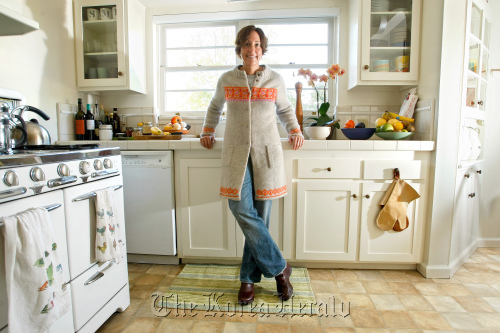LOS ANGELES ― Chef Suzanne Tracht is quietly elegant; her teenage daughter is beautiful and casually fashionable in black leggings. Their kitchen? Kind of like grandma’s house ― and that’s just how they like it.
Tracht doesn’t want to spend her off hours in a modern, stainless-steel kitchen that feels like the kitchens at her restaurant, the Beverly Boulevard chophouse Jar.
“I don’t want to come home from work and see that,” she says.
The atmosphere was set when she moved to the house in Beverlywood about a decade ago. Her friend, the artist Jill Young-Manson, painted a still life of pretty pink and yellow flowers in a pale blue vase near two blue teapots.
“It’s done on the back of a grocery bag,” Tracht says. “It was the first thing I put up in the house.”
At the other end of the room is something she bought from Young-Manson’s husband: an O’Keefe and Merritt four-burner range, with a chrome center piece that keeps food warm. A Chemex coffee maker, two French press pots and an espresso pot sit on top. Dish towels ― roosters on one, vegetables on the other ― hang on the oven door handles.
It’s a kitchen that’s worldly but cozy, a collection of things that carry family history and present-day preferences. Her mother’s squat silver sugar bowl and creamer sit on the breakfast table, and plates from Luna Garcia in Venice, California, hold fresh fruit and vegetables on the white tile counter. There’s a round vase holding small white roses, and near the sink there’s an orchid from Orchids Anonymous on 3rd Street.
 |
Suzanne Tracht, chef at Jar Restaurant in Los Angeles, poses in the kitchen at her home in Los Angeles, California, on Nov. 7, 2011. (LosAngeles Times/MCT) |
“Orchids are beautiful, and they’re low-maintenance,” Tracht says. “They’re nice, they mind their own business.”
She and her daughter, Ida Trevino, often eat in the breakfast nook, which is set off from the rest of the kitchen by a doorway and has its own built-in entertainment: One of their three rescue dogs, Juno, can jump high enough to peek in at the window.
Up on the shelf that surrounds the nook, Mexican dioramas include one of skeletons playing pool. The corner hutch has two ingenious triangular drawers that open toward each other. Its shelves hold a collection of seltzer bottles and four ivory-colored metal water jugs.
“I always stop at garage sales and antique stores,” Tracht says.
Next to the Young-Manson painting, on a narrow ledge, a wooden painted rooster seems to be inspecting the work. On another wall is a poster by de Roger Blachon in which a complete chaos of cooks and cakes and copper pots makes a mess in a delightfully wild restaurant kitchen. Spilled pastries, dirty dishes, even a toque-wearing pig at the stove fill every bit of space.
It’s the polar opposite of Tracht’s own kitchen. She good-naturedly complains about Ida and her friends leaving a mess in the kitchen ― pizza boxes and the remnants of pasta.
“I like my house nice and clean,” Tracht, 48, says in serious understatement.
The breakfast nook and, separated by a wall, a room for pantry and laundry lead through separate doorways to the working heart of the kitchen, a square area with the appliances and, of course, the food.
She has been cooking professionally since she was 19, when she left college for a job in the “very male” kitchen at the Arizona Biltmore hotel in Phoenix.
And sure enough, a few minutes later Ida walks in and says she doesn’t cook much but can use the O’Keefe & Merritt. “I learned how to do the oven because we don’t have a microwave,” she says with a glance at her mother.
Tracht cooks steak or a whole leg of lamb out back on an old-style Weber grill. She and her daughter eat lots of salads and make omelets or sushi, using ingredients from Tracht’s weekly farmers market trips.
“One of my joys is when my daughter gets up, I make her breakfast.”
Tracht has a set of brown plates she collected from the Heath factory outlet in Sausalito and some Laguna Beach consignment shop china.
Tracht was raised in a kosher home, where the rules of kosher eating would mandate different sets of dishes for different purposes. She does not keep a kosher kitchen now, but the effects of family never disappear, as Tracht acknowledges when she says of the china plates, which she uses for breakfast: “I would never put meat on this plate.”
By Mary MacVean
(Los Angeles Times)
(Distributed by MCT Information Services)








